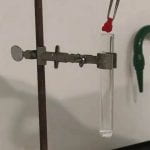DESCRIPTION:
Potassium chlorate is such a strong oxidizer that when a gummy bear, which is mostly sugar, is placed into it, the sugar is oxidized violently producing noise and a flame. This demo can be used to discuss strong oxidizers as well as how much energy is in sugar. The reactions proceed as follows:
TOPICS COVERED:
– exothermic reactions
– color change
– redox
– chemical change
– smell change
– melting
– energy transformations
MATERIALS NEEDED:
– potassium chlorate
– gummy bears or worms
– test tube (needs to have a large enough diameter to fit the candy)
– ring stand and clamp that holds the test tube
– tweezers
– hot plate or Bunsen burner or ethanol burner
PROCEDURE:
1. Place a small amount of KClO3 into the test tube (~1/4 inch of the test tube)
2. Position test tube, in the clamp, over the heat source until the KClO3 melts (open flames melt it much faster than hot plates)
3. Remove the heat source and turn it off
4. Carefully use the tweezers to place ½ a worm or a whole bear into the test tube
ADDITIONAL COMMENTS:
This reaction happens quickly, so be ready for it. Clean up is not the easiest because there are charred bits stuck to the test tube. The reaction produces a sweet burnt smell. Potassium chlorate must be molten, a solution of it does not produce the same effect. An open flame melts the potassium chlorate much faster than a hot plate. A similar demo can be done by blending sugar and potassium chlorate then using concentrated sulfuric acid to initiate the reaction.
SAFETY:
Potassium chlorate is a strong oxidizer! Goggles should always be worn, and the reaction should be done in a fume hood.
REFERENCES:
Shakhashiri, B.Z. Chemical Demonstrations; University of Wisconsin Press: Madison, 1983; Vol. 1, pp 79-80

